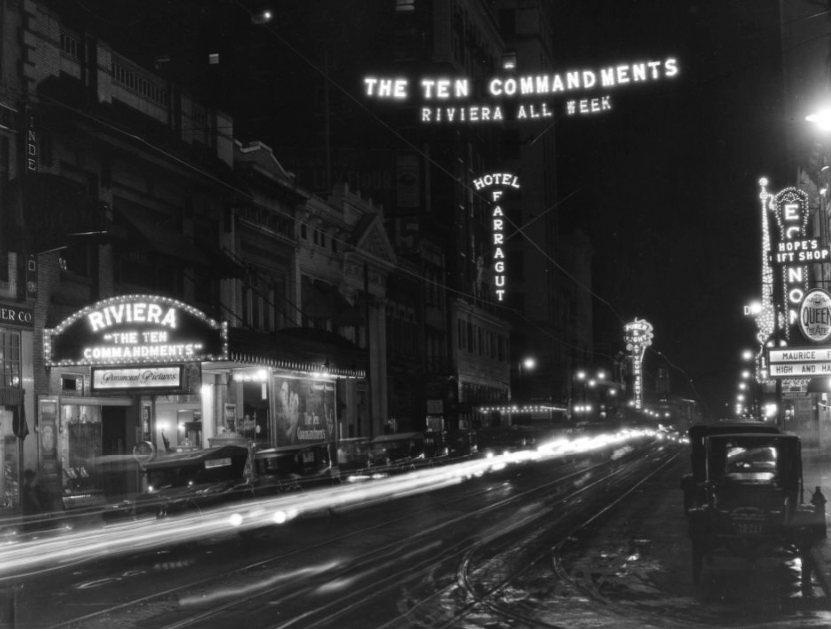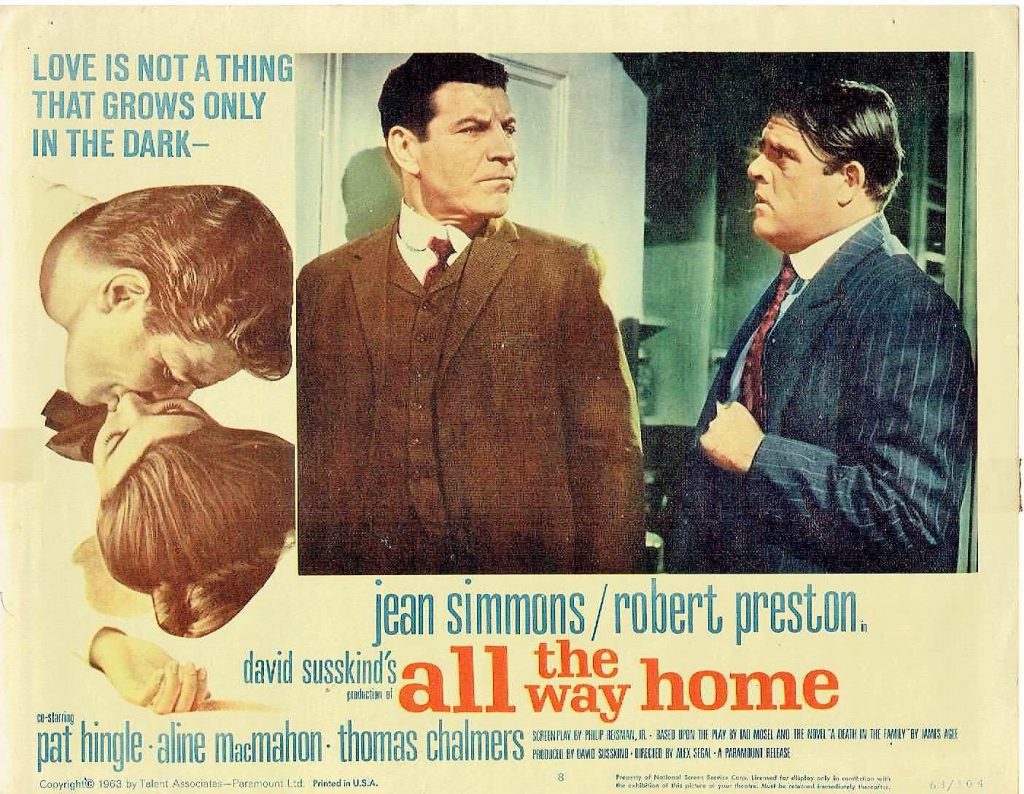
Guide Home • A History of Film in East Tennessee • A Love Letter to the UT Film Committee • A Deep Dive into Movies made in East Tennessee
Written by McClung Collection Manager Eric Dawson and TAMIS archivists John Morton and Janine Winfree for use in the exhibit Lights! Camera! East Tennessee! at the East Tennessee History Center, 2022-2023
Our relationship to moving images is constantly evolving.
Perhaps in your lifetime the most radical shift in the viewing of moving images, or “movies,” occurred with the introduction of home video formats, including VHS tapes, Laserdiscs, DVDs and Blu-rays. These formats–which, for the first time, allowed us to watch our favorite motion pictures over and over–are now primarily a collector’s format.
Today, our on-demand access to movies is furnished through streaming platforms, the popularity of which has disrupted how Hollywood traditionally financed and distributed its productions. The COVID-19 pandemic only accelerated our use and reliance on such platforms.
But how did our relationship with moving images begin?
What technological and cultural events sparked our interest in motion pictures as entertainment?
And what role has East Tennessee and its people had in moviemaking?
Lights! Camera! East Tennessee! tells the story of moving images, which begins in the past, a long, long time ago…
The invention of moving images was a marvel which cannot be attributed to one person. Amid the Second Industrial Revolution (late 1800s to early 1900s, also known as the Technological Revolution), what mattered most was not who discovered a new technology but who best marketed and distributed it to American consumers.
Inventor and businessman Thomas Alva Edison was an adept marketer. Known as the “Wizard of Menlo Park,” a nod to his laboratory in New Jersey, Edison’s fame stemmed from his development and promotion of electric power, mass communication and sound recordings.
Edison cemented his place in motion picture history with the Kinetograph, a motion picture camera invented by his employee William Kennedy Dickson. To commercialize the invention, Edison built and marketed the Kinetoscope, a wooden peephole viewer that was installed in penny arcades where people could view short films.
In East Tennessee, the first Kinetoscope was unveiled at Gooding’s Drug Store in Knoxville in 1895. Newspapers celebrated the “wonderful machine” for its faithful reproduction of scenes.
As the working class grew, Knoxvillians looked for new forms of entertainment. The Kinetoscope was cheap–one penny per view–and its 20-second offerings changed out regularly. While early motion pictures provided novel entertainment, many years passed before they were taken seriously as a form of storytelling.
Timeline
1839 – Photography was invented in Europe and quickly popularized in the United States.
1865 – Need to add zoetrope patent
1878 – Eadweard Muybridge, an English photographer, captured a series of photographs of a horse galloping, showing a sequence of movement.
1888 – George Eastman, an American entrepreneur, introduced the first film-based camera, the Kodak camera.
1889 – Kodak released the first roll of film, allowing for the quick creation of multiple photographs. Thomas Edison later adapted Eastman’s invention to create the long-lived 35mm format.
1891 – The Kinetoscope was invented by Thomas Edison and William Dickson.
1895 – In March, the Kinetoscope is unveiled at Gooding’s Drug Store in Knoxville, marking the first motion pictures displayed in East Tennessee.
In 1839, the first commercially viable photographic process was announced in Europe. Five years later, Knoxville had its first photography studio on Gay Street, operated a few doors south of the Lamar House (now Bijou Theatre) by Thomas H. Smiley. After the Civil War, Gay Street’s photographic emporiums influenced how Knoxvillians interacted with still images.
By March 1857, the Knoxville Register gave considerable coverage to “Daguerreian Galleries,” or photography studios, due to the “likeness-taking … setting in” among Knoxvillians. Thomas Harkness Smiley (active 1844-1845, 1853-1865, west side of Gay Street, two doors south of the Lamar House) and George Myers Sandifer (active 1857-1859, east side of Gay Street between Cumberland and Church) are profiled in the article, both of whom are referred to as “artists” and their photography as “art.”
The Rise of Urban Theaters
A few years passed before motion pictures became a routine part of life in Knoxville. When the city banned saloons in 1907 as part of Prohibition, citizens were thirsty for a new diversion. Motion pictures were an accessible quencher, especially since new technologies were allowing for more complex (read: entertaining) productions, including war scenes, religious dramas, sporting events and comedic skits.
With the popularity of motion pictures skyrocketing, many vaudeville theaters and playhouses converted their spaces to show films. As examples, Staub’s Opera House on Gay Street was early to convert. And successful businessman Cal F. Johnson opened the Lincoln Theater in the Black business district, likely as means to recoup revenue from his shuttered saloons.
In 1872, Swiss-immigrant Peter Staub gifted the city of Knoxville Staub’s Opera House (later Theatre) with seating for 1,400. Per societal norms of the time, a separate gallery was set aside for Black persons.
The theatre was known as the Lyric from the 1920s to the 1940s. It is now the site of the First Horizon Bank tower.
In 1910, the Bijou Theatre was built on Gay Street.
Amongst the urban theaters in downtown Knoxville, the Lyric Theatre’s history reflects the pre-history and development of cinema itself. Opened as Staub’s Opera House, the first venue of its kind in Knoxville, in 1872, the theater originally hosted a variety of 19th century entertainments, including opera and minstrel shows. With the turn of the century, the theater offered principally vaudeville, then cinema, changing names to Loew’s Theatre and finally to the Lyric Theatre along the way.
Similarly, the Bijou Theatre opened in 1909 as a vaudeville venue before making the change to cinema, which it exhibited in different capacities until the mid-1970s.
In contrast, Paramount purpose-built the Riviera Theatre in 1920 to be an outlet for its films; the theater changed ownership in the 1950s and operated until 1976.
The Tennessee Theatre was purpose-built as a silent movie palace, although it made its own conversion shortly after opening in 1929 to accommodate sound cinema.
Opening as a vaudeville house in 1930, the Roxy Theatre on Union Avenue exhibited second-run films to an earthier clientele than the prestige houses.
The Gem Theatre, once described as “the center of Negro business and professional life of Knoxville,” was the premier movie house for the Black community prior to integration.
Owned and managed by Walter C. Kennedy, the Gem was originally located at 102 West Vine Avenue, where it operated for seven years before moving to a larger building at the corner of Vine and Central streets.
On March 21, 1920, the Gem–rebranded as the Dixie Theatre–opened at 106 East Vine Avenue with a seating capacity of 1,400. Its building was large enough to house 20 businesses, including a candy store, barbershop and restaurant.
In July 1942, a fire destroyed the entire building, which was rebuilt primarily as a cinema. The “new” Gem housed an 800-seat auditorium, uniquely situated with the stage and screen near the front entrance. Patrons thus had to walk in front of the screen to get a seat.
The Gem Theatre, also described as “The shining Jewel of Knoxville,” closed in 1965.
In addition to mainstream movies, the Black movie theaters at Vine and Central showed the films of Oscar Micheaux, the pioneering Black filmmaker who began with ‘Homesteader’ in 1919 and ‘Within Our Gates’ in 1920. He made a total of 31 movies, many of them emulating the activities of white society using Black actors.
Suburban Theaters and Drive Ins
As Knoxville’s city layout began changing, so did the nature of moviegoing. With more and more people living in the suburbs, they began looking for entertainment closer to home. As a result, suburban theatres began to open outside of downtown Knoxville. The Picto opened at 1205 North Central in 1916, servicing the growing Happy Holler neighborhood. Though its name changed throughout the years, the theatre remained open until 1955, when most neighborhood theaters began to close as families turned to television for entertainment.
The rise of suburban theaters coincides with downtown Knoxville’s waning popularity in the mid-century, which the city sought to correct with Urban Renewal programs by reshaping the city to bring business back to downtown. The revitalization of the downtown district alongside the popularity of television was too much for some suburban theatres to overcome.
Cars also shaped the way people viewed movies in the mid-century. As the city changed to accommodate the growing population of automobile owners, businesses changed too. The first “drive-in” movie theater in Knoxville opened in 1947 with the Family Drive-In Theatre. As suburban theaters closed, theaters where viewers could simply drive and park to watch a movie became massively popular.
However, as large shopping malls brought shoppers back into the suburban areas of West Knoxville, suburban theaters were revitalized. Often attached to malls, the massive cineplexes that still survive today were constructed in the late 1980s and 1990s.
Many of these theaters are managed by Regal Entertainment, which started here in Knoxville in 1989.
On the site of the first suburban theater is Knoxville’s newest independent movie house, Central Cinema. Central Cinema was founded by creators of the Knoxville Horror Film Fest through a community crowdfunding campaign, opening in 2018. The popularity of this community theater shows that even if films are available on-demand to watch at home, there is something still valuable in the shared cinematic experience of a theater.

East Tennessee Representation in Early Motion Pictures
Reductive stereotypes of mountain residents that long existed in literature and illustrations quickly found their way into the new medium of motion pictures.
The earliest known motion picture set within Appalachia is ‘The Moonshiner’ (1904), produced by the American Mutoscope and Biograph Company. Though filmed in Scarsdale, New Jersey, the 13-minute drama depicts clashes between moonshiners and revenuers in the mountains of Kentucky.
Between 1904 – 1929, approximately 500 motion pictures were made with Southern mountaineers as their subject, most as one- to two-reel short films between 10 – 20 minutes. Though few of these nitrate films survive, plot summaries found in The Moving Picture World, a trade magazine, reveal that they perpetuated a variety of “hillbilly” stereotypes.
While it was more economical to make these narrative shorts in California or the Northeast, where film production infrastructure was already well in place, a handful of early films with a more documentary or newsreel approach were shot in southern Appalachia.
Introduction of Sound
“Talking Pictures” were first introduced to Knoxville in 1914, with Edison’s ill-fated Kinetophone. It allegedly failed to impress the Staub’s Theatre audiences, resulting in the technology being chased out of the theaters with jeers from moviegoers. Sound technology continued to be improved and tweaked over the years, but it was not considered a success until the national release of ‘The Jazz Singer’ (1927).
Although Knoxville didn’t have the technology to show Al Jolson’s famous singing film, the Riviera quickly stepped up with the proper technology to show the Vitaphone performance of ‘Tenderloin’ (1928). Unfortunately, this film also failed to impress movie goers, and Knoxville reviewers lamented how the primitive technology interrupted the film. Despite their complaints, “talkies” were here to stay, and both production houses and movie theaters made the switch to sound.
Introduction of Color
Just as sound technology continued to be improved throughout the years, so did color film. Early silent black and white films could be printed in color, either by coloring the film base (“tinting”) or the film image (“toning”). A combination of these techniques could be used to imitate natural colors or to help set the mood for the scene – for example, a nighttime scene might be tinted blue.
One of the first introductions of color film in Knoxville was the 1913 film ‘The Scarlet Letter,’ filmed in Kinemacolor, a process which required an alternating red and green filter over the projection. Color film became more celebrated as Technicolor improved its technology first introduced in 1916, with several 1929 features released in color.
Black and white film continued to be popular due to its affordability. Color film would not dominate feature film releases until the mid-1960s.
East Tennessee on Film
The word “film” is most often associated with feature-length narrative motion pictures, usually made as entertainment by Hollywood studios and known colloquially as “movies.” However, in the nearly 130 years since its development, the majority of motion picture film has not been shot and processed for box office distribution. Rather, the bulk has been used to produce newsreels, documentaries, industrial films, itinerant films and home movies, all of which are intended for specific audiences, many local or regional.
Clarence Brown: The Engineering Director
In 1914, Clarence Brown sought a foothold in the movie business, at a time when the young industry stood on the brink of consolidating into the Hollywood system. Brown, desirous of combining his interests in engineering and the performing arts, landed an assistantship with director Maurice Tourneur, an innovative filmmaker with a distinct artistic vision, and quickly proved capable of working in all aspects of film production.
Following brief service during World War I, Brown concluded his apprenticeship with Tourneur and began carving his own niche in the Hollywood system, where studios assigned a continuous stream of film projects to contracted performers, technicians and administrative personnel. By 1923, Brown was under contract at Universal Pictures, where he established the professional patterns that would bring him success for the next three decades in Hollywood.
In retirement, Brown renewed his relationship with the University of Tennessee, which prompted return visits to Knoxville and resulted in his contributions for the founding of a namesake performing arts theater on campus in 1970.
The university was also the site of the Clarence Brown Film Festival–a 1973 retrospective with Brown in attendance–where students and film fans thronged to workshops, lectures, and screenings. The festival confirmed that film scholars had recognized the self-effacing Brown’s place in cinema history on the basis of his films themselves, and Brown set the keystone of his legacy by donating his personal archives to the university. Like the style of his films, it was a rich but subtle gesture.
Sam Orleans
Starting his career in the motion picture business as a 14-year old projectionist in Albany, NY, Sam Orleans (1899-1964) went on to become an itinerate news stringer, before honing his craft as an industrial filmmaker at Eastman Teaching Films and General Business Films. He moved to East Tennessee in 1934 after accepting a job as a cameraman for the Tennessee Valley Authority, shooting films to promote the new agency’s flood control projects and dam construction.
In 1946, Orleans opened Knoxville’s first professional film studio at 211 W. Cumberland, specializing in industrial films using local locations and actors, including a 13-year old Cormac McCarthy, who featured in ‘Dairying in Tennessee.’ Orleans’ audience far exceeded Knoxville, however, as prints of his film ‘Your Health Department in Action’ were sent to 47 cities in 30 states, some traveling as far as Canada and Puerto Rico. Other notable films produced by Sam Orleans Studios include ‘Today’s News, Tomorrow’s Men,’ which offered a fascinating look behind the scenes of the Knoxville News-Sentinel, and the Driver’s Ed classic ‘The Sixth Wheel.’ In addition to East Tennessee businesses and government agencies, his clients included du Pont, General Electric, U.S. Rubber, the Atomic Energy Commission and the U.S. Air Force.
Orleans was aboard United Airlines flight 823 when it crashed outside of Parrotsville, TN on July 9, 1964. There were no survivors among the 35 passengers and four crew members aboard.
Postwar Moviegoing: Declining Admissions and Gimmicks
American movie attendance peaked at 90,000,000 people (or 63% of the population) going to the movies each week in 1946. In following years, numerous factors diluted the moviegoing public. Anti-trust legislation compelled the major studios to divest their urban theater chains, driving up the cost of tickets. A boost in postwar standard of living for many Americans ushered in the rise of automobile and suburban domestic culture, as well as more expensive pastimes than moviegoing.
And the ascendance of television brought moving images directly into suburban homes.
The film industry employed various strategies to entice lapsed moviegoers away from their television sets and back into theaters. New photographic processes yielded sharper images on bigger, wider or contoured cinema screens; and new soundtrack technologies enveloped audiences in a high-fidelity audio mix from two or more sound channels. 3-D movies and wider use of color photography further distinguished feature films from early television. Lavish prestige films with high production values and long runtimes would tour the country in exclusive roadshow engagements, commanding premium admission prices for presentation only in deluxe theaters before wide release to more modest venues.
Drive-in theaters exploded in popularity as family-friendly destinations for a whole evening’s entertainment on a budget, complete with playgrounds and snack bars; a third space for a generation of teenagers with cars; and a permissive venue where provocative films could reach an audience.
All the Way Home … to the Tennessee Theatre
In the fall of 1962, Hollywood dazzled Knoxville. Directors, actors and cameramen descended on the Fort Sanders neighborhood to shoot ‘All the Way Home’ (1963), the film adaptation of James Agee’s novel ‘A Death in the Family.’
The Hollywood crew drew a curious public, eager to catch a glimpse of actors, such as Robert Preston, who was at the height of his fame from ‘The Music Man’ (1962). Some even brought their home movie cameras, capturing “behind the scenes” footage of the actors at work.
Those who thought that Hollywood was finished with Knoxville when the production wrapped were pleased to be mistaken. Paramount Pictures scheduled the world premiere of ‘All the Way Home’ in Knoxville, promising the city would go “strictly Hollywood” on October 17, 1963.
Knoxville spruced up downtown for the silver screen debut by temporarily renaming Gay Street as “Agee Street” and adding street signs that read “All the Way Home” along the route to the Tennessee Theatre.
Preston and his young co-star Michael Kearney were on hand, as was producer David Susskind. In a nod to the movie’s setting, the stars were brought from the Andrew Johnson Hotel to the Tennessee in a motorcade of vintage automobiles.
Knoxville’s role in ‘All the Way Home’ left city leaders hopeful that Hollywood would again find its way to East Tennessee. James Agee Memorial Studio was built later that year to support movie productions. Located behind West High School, the short-lived studio became a community activity center and later a part of the school.
Two 1960s productions that Hollywood brought to East Tennessee conjured competing visions of the region from the landscape. In 1965, ‘The Fool Killer’ adapted Helen Eustis’ Gothic-tinged novel of a runaway boy’s wanderings in the post-Civil War South and encounters with its denizens, including a troubled veteran played by Anthony Perkins. In addition to offering a realistic backdrop for the story, East Tennessee would have offered the independent production a more budget-friendly shoot than Hollywood facilities.
A more conventional production, ‘A Walk in the Spring Rain,’ came to East Tennessee in 1969 to shoot scenes in Cades Cove, Gatlinburg and on the University of Tennessee campus. These scenes joined footage shot in Los Angeles in the final cut of this Columbia film. The contrasting sophisticated campus and rustic mountain settings of the region underscored the film’s story of a relationship between a cosmopolitan woman and a mountain man, played by Ingrid Bergman and Anthony Quinn.
James Agee
Although James Agee spent most of his life outside East Tennessee, his boyhood in Knoxville influenced his writings. Agee grew up in Fort Sanders, the son of a well-connected mother and working-class father whose death when James was six left a lasting impression. A restless but gifted student at prestigious schools, Agee developed strong literary ambitions, an interest in cinema and an alcohol habit.
Fresh from Harvard in 1932, Agee joined the staff of Fortune magazine, where his articles attracted notice. In 1936, Agee and photographer Walker Evans profiled sharecroppers coping with the Great Depression in Alabama. The material was published as ‘Let Us Now Praise Famous Men’ in 1941, about the time Agee became the regular film critic at Time magazine. The literary flair and critical analysis he employed in the column distinguished his reviews from typical industry coverage, and The Nation brought him on for their film coverage as well.
As Agee emerged as a respected commentator on cinema, feature assignments in Hollywood connected him to such figures as Charles Chaplin and John Huston, both of whom he had celebrated in print. Huston hired Agee to script ‘The African Queen’ in 1950; additional film writing projects and fraternizing with the cultural vanguard busied Agee in Los Angeles for the next few years. Despite deteriorating health, Agee managed to publish fiction and complete film writing projects up to his death in 1955. His final novel, ‘A Death in the Family,’ and his final film adaptation, ‘Night of the Hunter,’ are regarded as masterpieces, with the former receiving a posthumous Pulitzer Prize in 1957.
Long Gone the Days of Film
In the late 1990s, digital video was increasingly used by filmmakers, and within 10 years, the majority of theaters in the United States replaced film projectors with digital ones. Today, movies shot entirely on film are a rarity, and only a few boutique theaters can still project 35mm films.
With the barrier of expensive film stock and production costs removed, low-budget films are being made in more locations, allowing filmmakers to highlight the uniqueness of their own regions. More robustly budgeted indies and Hollywood productions are also looking farther afield, shooting outside the hubs of Los Angeles, New York and Atlanta. East Tennessee is no exception to this trend.
The launch of Film Fest Knox could further cement Knoxville’s place in the lexicon of movie making history.
Keep reading for more recent history and the full festival schedule and be sure to visit the East Tennessee History Center during your next trip downtown.
Guide Home • A History of Film in East Tennessee • A Love Letter to the UT Film Committee • A Deep Dive into Movies made in East Tennessee








